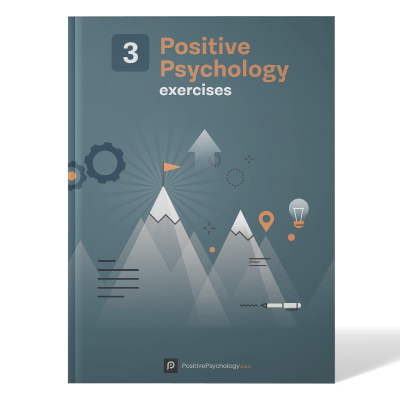Role Play in Therapy: 21 Scripts & Examples for Your Session
 Role-play has multiple uses related to mental wellness and therapy.
Role-play has multiple uses related to mental wellness and therapy.
It is a technique that doesn’t require any costumes or makeup, and it is a valuable technique for students learning about mental health and psychotherapy, since it is a powerful tool in the treatment itself (Rønning & Bjørkly, 2019).
Role-playing scripts can be particularly helpful with reticent clients, replacing more traditional talk therapy techniques when individuals feel guarded or suspicious.
It is also a helpful and relatively nonthreatening approach that can assess, intervene, and engage clients in therapy, especially children (Hackett, 2011).
This article explores the value of role-play as a therapeutic technique and introduces scripts, exercises, activities, and questions to help.
Before you continue, we thought you might like to download our three Positive Psychology Exercises for free. These science-based exercises explore fundamental aspects of positive psychology, including strengths, values, and self-compassion, and will give you the tools to enhance the wellbeing of your clients, students, or employees.
This Article Contains:
- How Role-Play Works in Therapy
- 4 Real-Life Psychology Examples
- Does It Work? 9 Proven Benefits
- 3 Scripts and Worksheets for Your Sessions
- Role-Playing Activities, Scripts, Games, & Exercises
- 9 Techniques and Questions to Ask Clients
- A Look at Role-Play in Group Therapy
- Best Resources From PositivePsychology.com
- A Take-Home Message
- References
How Role-Play Works in Therapy
“Role-playing in supervised groups seems to promote reflection and insight not only for students in the patient and therapist roles but also for peers observing the group sessions” (Rønning & Bjørkly, 2019, p. 415). Indeed, learning and practicing techniques in such a safe and controlled environment can promote competent practitioners.
For clients in therapy, role-playing scripts offer a replacement for some aspects of more typical talk therapies (Hackett, 2011). “Role-playing has emotive, cognitive, and behavioral components” that can create disturbances that help clients change “unhealthy feelings to healthy ones” (Corey, 2013, p. 300).
When reenacting scenes from their lives, people typically become more psychologically engaged than if they were simply reporting anecdotes about themselves (Corey, 2013).
Clients can use such exercises to work through their feelings and irrational beliefs in an imagined past, present, or future situation. Children, in particular, can find it helpful as an opportunity to act out problematic behavior while providing a performance-based learning experience (Corey, 2013; Dobson, 2011).
Typical role-play includes two or more people re-enacting a specific problematic scenario–actual or imagined–sufficiently authentic to evoke an emotional reaction. For example, the therapist may play the role of parent or teacher, using words, mannerisms, and responses gathered (by systematic questioning) from the child to explore a situation (Hackett, 2011).
As a therapeutic technique, role-play offers helpful insight into how individuals view their environment and function interpersonally. For that reason, it can be particularly effective in the treatment of trauma, enabling therapist and client to revisit earlier experiences through reenactment (Hackett, 2011).
It may be helpful to move furniture around in the office to recreate the environment, for example, a family living room or work setting, to better capture how clients currently react to a situation (Nelson-Jones, 2014).
4 Real-Life Psychology Examples

Clients can practice and improve their assertive and social techniques while learning to manage their anxiety, aggression, and other interpersonal difficulties (Hackett, 2011).
Real-life examples of role-play, modified from the literature, include:
- A student anxious about their application to graduate school feels stupid and unworthy.
Role-playing an imagined interview with the college Dean uncovers the client’s specific beliefs and anxieties, challenging their thoughts about what it could mean not to be accepted (Corey, 2013). - Client and parent, Rich typically gets excessively angry when his daughter stays out late.
The therapist asks him to role-play a prior situation using the new coping skills he has learned, providing a safe opportunity to make mistakes and improve handling going forward (Nelson-Jones, 2014). - A client consistently performed poorly in interviews for management positions.
The client role-plays a future interview, with the therapist acting as the interviewer using a set of questions that could cause the client difficulty. The meeting is video recorded for later review and skills evaluation. Guided mental imagery is then used to rehearse target skills before future interviews (Nelson-Jones, 2014). - A student has communication and confidence difficulties with their professor.
The therapist teaches them assertiveness skills, then role-plays meetings with the professor to try out their newly acquired techniques (before an actual meeting). Practice helps the client manage their fears and improve their relationship with their professor (Corey, 2013).
Role-play is helpful in placing clients in safe environments for practicing difficult or distressing situations and trialing new coping skills and emotional responses (Dobson, 2011).
Does It Work? 9 Proven Benefits
Role-playing scripts have many tried-and-tested benefits (some identified anecdotally rather than research-driven) to aid the therapeutic process and improve the likelihood of positive treatment outcomes.
Potential benefits of role-play include (Nelson-Jones, 2014; Hackett, 2011; Corey, 2013):
- Providing valuable assessment opportunities to uncover how clients think and act in situations.
- Offering the chance to practice skills learned during treatment.
- Working together, therapist and client can create and try out styles and approaches for verbal and non-verbal communication.
- Practicing how to cope with a range of responses from others.
- Trialing the transfer of learned skills to real life to recognize their value while practicing overcoming obstacles.
- Benefiting skills training by providing the opportunity to practice social skills, assertiveness, and other interpersonal and communication-related skills.
- Using interruptions from therapists to create disturbances in what clients tell themselves, helping turn unhealthy beliefs into healthy ones.
- Providing the opportunity to role-play problem situations clients face in their daily lives.
- Helping to learn coping strategies to avoid impulsive and aggressive behavior, social anxiety, test fears, eating problems, and public speaking anxiety.
3 Scripts and Worksheets for Your Sessions

Introducing role-play in therapy is a skill that requires practice and focus to ensure that the client can try out their new skills and coping mechanisms. The therapist must be clear in their expectations and help the client by (Nelson-Jones, 2014):
- Explaining the reasons for role-play
- Setting the scene
- Assessing their current communication skills and behaviors
- Formulating new or changed communication skills and behaviors
- Rehearsing the new skills and behaviors
- Encouraging the client to rehearse their skills inside and outside counseling sessions.
Scripts (even partial ones) can help by focusing attention and providing the client with clarity on what is expected.
Empty chair
The empty chair (sometimes called two chairs work) experiment is one of the most widely used methods in Gestalt psychology and provides a slight twist on the idea of role-play. It “offers a voice to the client’s experience and is a way of recognizing and re-owning alienated qualities” (Joyce & Sills, 2014, p. 100).
The client is asked to imagine someone from their past or present sitting in the chair opposite. They then talk openly about how they feel as though the person were there.
A typical script might be a variation on the following:
If your husband were in the room, how close would he be sitting or standing?
Now, with your eyes closed, imagine what he is wearing. How is he sitting or standing? What expression is on his face?
Now, slowly opening your eyes, imagine looking at him, sitting (or standing) in front of you.
What emotions do you feel?
What would you like to say to him?
At this point, the therapist is likely to begin to grasp the difficulties their client has with the person, situation, or emotions. For example, they may say, “He looks stern and criticizes me.”
The therapist may offer questions such as, “How risky would it be to tell him to stop?”
The empty chair role-play encourages the client to think about how they feel regarding the situation and the person and try alternate ways of coping and behaving.
Unfinished business
Sometimes a client can feel stuck regarding their relationship with someone alive or dead. The client may need to stay with such feelings of discomfort or “stuckness.”
Role-play – where the therapist plays the other person – can help push the conversation further and continue without avoiding how they wish things to change (Joyce & Sills, 2014).
The therapist can temporarily halt the role-play to ask the following questions, digging deeper into the client’s thoughts and beliefs on each one (modified from Joyce & Sills, 2014):
What are you afraid will happen if you assert yourself and make demands of X?
[The client answers.]
And then what would happen?
[The client answers.]
And what then?
[The client answers.]
And what would that look like?
While the therapist should handle questioning carefully, gently nudging the client’s thought process along, pushing them to face up to realities can be powerful. Once answered, the therapist can resume role-play.
Assertive Message Role-Play
This worksheet provides a helpful script and role-play exercises to help work through issues with assertiveness at work.
Potential scenarios include:
A coworker is being rude about another coworker.
Someone in the office comes to you and wants to gossip about your friend.
Your coworker won’t return your calls.
A coworker is taking personal phone calls in your area and talking about very personal issues you prefer not to hear.
CBT role-play – depressive symptoms and lack of motivation
Role-Playing Activities, Scripts, Games, & Exercises
Activities and games can enhance the effectiveness of role-play and provide new opportunities to explore client thinking, feelings, behaviors, and learned skills (Mann, 2010).
Top dog–underdog
When the therapist notices clients are holding two opposing (and sometimes extreme) opinions or attitudes, it’s helpful to ask them to play each one in a role-play.
The client plays top dog, demanding that everything is done their way, and then underdog, where they play the disobedient, rebellious self who doesn’t do as told.
For example (modified from Mann, 2010):
Top dog: I need to get down to the gym and get in shape.
Underdog: Who cares! I want to grab a burger and have a lazy day!
Aha experience
In this variation of the two chairs exercise, the aim is to help the client experience a moment of insight (Mann, 2010).
“The ‘Aha’ experience can be facilitated through experimentation” (Mann, 2010, p. 222). For example, suppose a client is stuck deciding whether to take a new job. In that case, they move to the other seat, representing their new position (literally and emotionally), to comment from that place. They can role-play the impact of inaction and action from both positions and see how it feels, how they think, and the effect on their potential behavior.
Intellectual–emotional role
When other techniques cannot help a client become unstuck, the following Cognitive-Behavioral Therapy role-play can be helpful (Beck, 2011).
In an existing or imagined situation, the client is asked first to play the role of their emotional self. They act and behave according to their dysfunctional or unhelpful beliefs. Next, they approach the same situation using their intellectual self, where they recognize their ideas were wrong or unhelpful. For example:
Emotional self: I am useless because I didn’t get all A’s
Intellectual self: It was a tough test; no one got all A’s.
9 Techniques and Questions to Ask Clients

After role-play has ended, it’s helpful to ask the client several questions to encourage metacognition (Beck, 2011; Mann, 2010):
- What did you learn about yourself?
- How did you feel in each role you played?
- What did you discover?
- Did you come to a better understanding of how you or another felt?
- If so, what was that understanding?
- What do you think you will do differently the next time you face this situation?
Soliloquy
During role-play, it is helpful for the person playing the role to think out loud, explaining their thoughts, beliefs, emotions, and rationale behind their behavior (Baim et al., 2007).
Role reversal
Playing each side of a role-play means that the client enters into each character, walking in their shoes and considering how the same situation may be experienced differently (Baim et al., 2007).
Past and future
Any character (alive or dead) from a real past or an imagined future can be brought to life and worked through as many times as needed. There are no limits, and a situation may become better understood the more it is revisited.
A Look at Role-Play in Group Therapy
Group therapy should never be thought of as second class when compared with individual therapy, as it offers a wide range of experiences for self-growth, particularly using role-play (Mann, 2010).
Role-play can be helpful with children who may not yet have the words to describe how they feel or to put in place coping mechanisms to handle extreme emotions such as anger (Snowden & Rebar, 2018).
2 Games for your group sessions
Group sessions can use games to explore and understand difficult situations and experience strong emotions.
Best and worst – Anger management
Anger can be a difficult emotion to anticipate and manage.
In a group environment, ask children (or adults) to come up with a list of situations that typically make people angry.
Ask for volunteers to come up to the front and play one person handling a situation well and managing their anger and another handling it poorly and showing their worst side.
Reflect on how the person may have felt when they got angry and how people nearby could have been impacted.
Asking for what I need
It is not always easy asking for what we want.
Ask the group to think of a situation where they fail to speak out (perhaps in class or at work) and how they react. Discuss how they are left feeling.
In pairs, practice asking for what they want in those situations, using one of the following approaches (modified from Snowden & Rebar, 2018):
I’m feeling (e.g., upset) …
and I need to (e.g., explain how I feel to you).
Or
It’s hard to talk right now, but I (e.g., need a few moments).
Can we talk later?
Or
I feel (e.g., really angry) …
And I’m not sure what I need/want. Can you help me figure it out?
Having worked through the exercise in pairs, ask for volunteers to explore what worked well in front of the group.
Best Resources From PositivePsychology.com
Role-playing scripts are one of many ways to learn to manage emotions. We have other techniques available to help therapists work with their clients to understand their feelings.
Some essential free resource include:
- Imagery-Based Exposure Worksheet
This helpful worksheet is designed to guide clients through exposing themselves to strong emotions. - Decatastrophizing Worksheet
These five progressive questions take the person through the process of decatastrophizing a catastrophe. - Radical Acceptance Worksheet
This exercise helps the client manage intense negative emotions and experiences by acknowledging that it is possible to respond mindfully rather than emotionally. - Skills for Regulating Emotions
We often focus on negatives more than positives. This valuable exercise helps us redress the balance.
More extensive versions of the following tools are available with a subscription to the PositivePsychology.com Toolkit©, but they are described briefly below:
- Passengers on the Bus Group Activity
Acceptance and Commitment Therapy uses the passengers on the bus metaphor to help practice observing and accepting emotional experiences.
The bus driver (volunteer from the group) talks to their passengers (other volunteers, representing distressing emotions), attempting to quiet them and enable the bus to continue in its valued direction. The aim is to learn to acknowledge each one without reacting, seeing them as simply part of the journey.
- When Hot Buttons Are Pushed
Strong emotions can be linked with tendencies to act in specific ways. This tool is designed to make group members aware of things that can easily trigger negative emotions and lead to impulsive reactions.- Step one – Identify what triggers strong emotional reactions.
- Step two – Understand the reactions.
- Step three – Identify coping strategies.
- Step four – As a group, discuss their effectiveness.
If you’re looking for more science-based ways to help others enhance their wellbeing, check out this signature collection of 17 validated positive psychology tools for practitioners. Use them to help others flourish and thrive.
A Take-Home Message
Role-play in therapy has the potential to help clients not previously helped by other treatments. By creating this safe environment, it offers a controlled place to visit past, present, and future situations that cause clients emotional upset.
Individuals reenact scenes, work through problematic behavior, then reflect on emotional, cognitive, and behavioral aspects of what they experienced.
Role-play is particularly helpful for practicing new skills – social or communicative – in potentially difficult situations. The client can identify coping mechanisms that work for them and uncover unhelpful or problematic behaviors that need addressing.
When appropriate, role-playing scripts can direct attention and focus on particular aspects of a situation. The therapist can stop the action to question what the client was thinking or feeling or suggest alternative approaches for handling what is happening.
Role-play offers a valuable approach that can be integrated into most therapeutic treatments to stimulate changes in thinking and behavior and learn to manage emotional responses.
We hope you enjoyed reading this article. Don’t forget to download our three Positive Psychology Exercises for free.
- Baim, C., Burmeister, J., & Maciel, M. (2007). Psychodrama: Advances in theory and practice. Routledge.
- Beck, J. S. (2011). Cognitive behavior therapy: Basics and beyond. Guilford Press.
- Corey, G. (2013). Theory and practice of counseling and psychotherapy. Cengage.
- Dobson, K. S. (2011). Handbook of cognitive-behavioural therapies. Guilford Press.
- Hackett, D. (2011). Role-playing. In S. Goldstein & J. A. Naglieri (Eds.), Encyclopedia of child behavior and development (p. 127). Springer.
- Joyce, P., & Sills, C. (2014). Skills in gestalt counselling & psychotherapy. Sage.
- Mann, D. (2010). Gestalt therapy: 100 Key points and techniques. Routledge, Taylor & Francis Group.
- Nelson-Jones, R. (2014). Practical counselling and helping skills. Sage.
- Rønning, S. B., & Bjørkly, S. (2019). The use of clinical role-play and reflection in learning therapeutic communication skills in mental health education: An integrative review. Advances in Medical Education and Practice, 10, 415–425.
- Snowden, S., & Rebar, S. (2018). Anger management workbook for kids: 50 Fun activities to help children stay calm and make better choices when they feel mad. Althea Press.
Let us know your thoughts
Read other articles by their category
- Body & Brain (50)
- Coaching & Application (57)
- Compassion (26)
- Counseling (51)
- Emotional Intelligence (24)
- Gratitude (18)
- Grief & Bereavement (21)
- Happiness & SWB (40)
- Meaning & Values (26)
- Meditation (20)
- Mindfulness (45)
- Motivation & Goals (45)
- Optimism & Mindset (34)
- Positive CBT (29)
- Positive Communication (20)
- Positive Education (47)
- Positive Emotions (33)
- Positive Leadership (18)
- Positive Parenting (4)
- Positive Psychology (33)
- Positive Workplace (37)
- Productivity (17)
- Relationships (46)
- Resilience & Coping (38)
- Self Awareness (21)
- Self Esteem (38)
- Strengths & Virtues (32)
- Stress & Burnout Prevention (34)
- Theory & Books (46)
- Therapy Exercises (37)
- Types of Therapy (64)





What our readers think
In this video, I notice that the cause of her feelings is from self abandonment because she has been emotionally invalidated growing up and has experienced abandonment, which has taught her to overlook her needs prioritising the needs of others (husband, kids) from listening to her story. The tone of her voice is flat, empty and has grief in it. She says ‘I’ a lot not ‘we.’ She has had to do all this by her self all these years! And now she barely understand her own self, why or emotional self. Her husband is not taking her out anywhere nice to cheer her up? And just went out to work? And no family time to include kids as well? Why isn’t the counsellor mentioning this to her? 1. She needs good friends who understand her well 2. What does she like doing? Hobbies and interests that being her joy 3. Start journalling 4. Start to self parent 5. Love yourself
i love reading this. it helps a lot. thanks
This is one of the most practical resources I have read on the subject matter